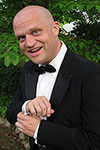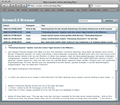Screen2.0
interview // 2009.01.29 08:56:59 [hh]
Alien Skin Gründer Jeff Butterworth: "I see software replacing expensive complicated hardware"
 Mit Jeff Butterworth, Gründer und Chef ("Queen Bee") der US-amerikanischen Foto-Software-Schmiede Alien Skin Software (Urheber zahlreicher Photoshop-Plug-ins wie "Eye Candy", "Xenofex", "Image Doctor", "Exposure", "Snap Art", "Bokeh" und "Blow Up") sprach Screen2.0 über Unkonventionelles, Historisches, Erfolgreiches und Kommendes ("Eye Candy 6", "Snap Art 2" und "Exposure 3"). Lesen Sie hier das Interview in voller Länge und in englischer Sprache.
Mit Jeff Butterworth, Gründer und Chef ("Queen Bee") der US-amerikanischen Foto-Software-Schmiede Alien Skin Software (Urheber zahlreicher Photoshop-Plug-ins wie "Eye Candy", "Xenofex", "Image Doctor", "Exposure", "Snap Art", "Bokeh" und "Blow Up") sprach Screen2.0 über Unkonventionelles, Historisches, Erfolgreiches und Kommendes ("Eye Candy 6", "Snap Art 2" und "Exposure 3"). Lesen Sie hier das Interview in voller Länge und in englischer Sprache.
Screen2.0: Screen already traces your work for more than 15 years now. I remember blue-haired Will Connor (PR manager aka "specialist for paranormal encounters") visited us in our hamburg office way way back in stone age. Your company has a long tradition in specialized plug-ins and very interesting tools. What is your background?
Jeff Butterworth: I fell in love with pixels as a child when I saw early video games like Pong and Space Invaders. When I was 12 I took a computer class using an Apple IIe. The teacher showed me the command to turn on a pixel and it was a like a junky being given his first dose of heroin. I haven't been able to stop playing with computer graphics since then. I did research in medical imaging and virtual reality at the University of North Carolina at Chapel Hill. That is where I learned advanced computer graphics techniques. After getting a masters degree, I dropped out of graduate school to start Alien Skin Software.
Screen2.0: When was the time when you knew that this company is going to be successful?
Butterworth: The first year was a real struggle. We didn't have any investment money, so it was hard to get started. We licensed a few filters to Corel, which finally gave us some cash to make the company run smoother. Our sales started growing rapidly in the second year and then I knew we would be successful.
Screen2.0: Alien Skin had always the image of not being a "normal" company. What is different?
Butterworth: I was a good kid growing up, so I never had my rebellious teenage years. But when I was 25 I decided to start being alternative, which is why I dropped out of graduate school to start Alien Skin. So, from about 1993 to 2001 we were pretty punk rock. I had blue hair, green fingernails, and a pierced tongue. I tried to make Alien Skin the opposite of a stuffy corporation. But then we started to calm down and get more serious from about 2002 until now. These days no one has blue hair, but this is still a pretty fun place to work. We don’t have a lot of rules, everyone is treated with respect, and we have good benefits like health insurance for employees and their families.
Screen2.0: How many people work for Alien Skin today?
Butterworth: Nine people work at Alien Skin today, including me. That is much less than the 20 people we had in 2001 even though our revenue is actually higher now. We don’t work harder. The work week is still 40 hours. We just understand how to get things done more efficiently.
Screen2.0: While the first plug-ins were more about artistic effects, the newer are more about photorealistic simulation (maybe except for "Snap Art"). Does this correspond to how Photoshop usage has shifted in the past few years?
Butterworth: Our first big experiment with photography products was Exposure. It was a big hit, so all our new products since then have been about photography: Snap Art, Bokeh, Blow Up, Image Doctor. We shifted to photography because that is what has been selling well for us. My guess is that the shift from film to digital photography has made the Photoshop community much more oriented toward photography.
Screen2.0: What makes "Bokeh", "Exposure 2" and "Snap Art" unique in your eyes?
Butterworth: Bokeh lets you creatively manipulate focus in a photo after it has been shot. You can decrease the depth of field or simulate tilt-shift lenses to draw the viewers attention where you want it.
Exposure is our film simulator. It realistically makes a digital photo look like it was shot on film. It even simulates films that have been discontinued, like Polaroid, AGFA Scala, and GAF 500. Exposure's grain is detailed and organic, not like Photoshop's noise filter.
Snap Art turns photos into natural media, such as oil point or a pencil sketch. The results look like they were made by hand, not computer like the filters built into Photoshop. Snap Art is easy to use and completely automatic. It does not require a pen tablet or classes to learn how to use it.
Screen2.0: What kind of products can we expect in the near future? Will there be more "Eye Candy" tools?
Butterworth: We are working on Eye Candy 6 and it should be out near the end of the year. Aside from that, most of our plans continue to center on photography. We also plan to release Snap Art 2 and Exposure 3 this year.
Screen2.0: Can you tell us a little bit about the features of those forthcoming products?
Butterworth: Snap Art 2 will be even easier to use than Snap Art 1. You will be able to place ovals on your photo where you want more detail. Typically you would put an oval on a face in a portrait. Snap Art 2 would use large abstract brush strokes in most of the image and smaller brush strokes for more detail on the face. Snap Art 2 will also take advantage of multi-processor and multi-core computers to run faster.
I can't give many details on Exposure 3 or Eye Candy 6 because we are still finalizing some of the plans. I can say that both will have more presets. Eye Candy 6 will be much easier to use because the effects will adapt to the image size.
Screen2.0: Where do you see the major trends today in digital photography and design?
Butterworth: In design, I see more simple and clean looks rather than flashy crazy effects like in the days of Kai’s Power Tools. In digital photography I see software replacing expensive complicated hardware. For instance, our Bokeh product lets you manipulate focus in software rather than spending a lot of money on expensive lenses.
Screen2.0: Jeff, thank you very much for the interview.
Weitere Informationen: www.alienskin.com
Werbung












